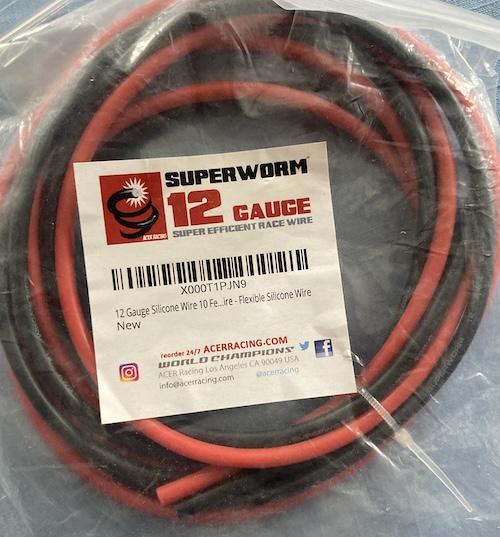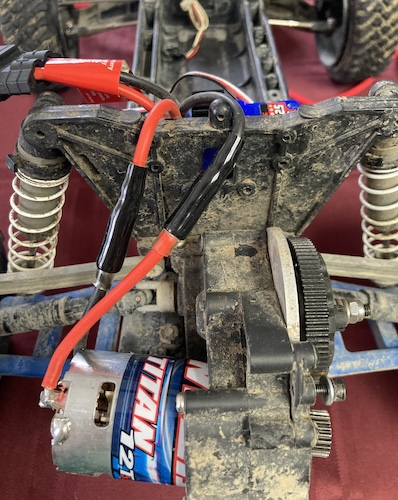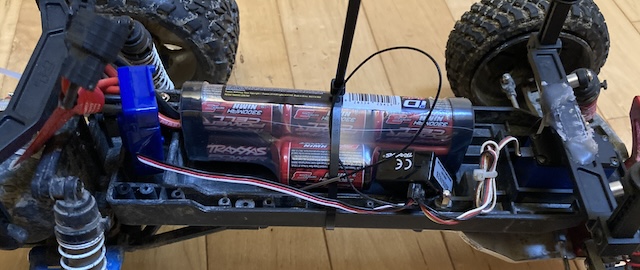Starting a Stampede
Tags: rc traxxas stampede stampede2wd
First working machine posted on this blog! This story is all about re-powering my Traxxas Stampede 2WD, which was given to me alongside a big bin of parts. Some of those parts are the right ones, and some of them are the wrong ones. The only way to figure out which is which is to do the world’s greasiest 3D jigsaw puzzle.
Electronics
I was pretty sure I had all the parts for the Traxxas Stampede, so I set about trying to figure it all out. On the kitchen table, I opened every box that I had received until I had a pretty competent set of electronics, featuring:
- An XL2.5 brushed ESC;
- A Traxxas 12T/550 brushed motor;
- The Traxxas TQ receiver;
- The Traxxas TQ transmitter
After a lot of fiddling, I managed to get the ESC programmed properly. The biggest problem I made was that I had confused the single red blink for a double red blink and was doing things at the wrong time. This took me like an hour to figure out.
Right after that all worked, I was able to make the Traxxas steer its front wheels, and also spin the motor that was sitting loose on my kitchen table.
Transmission
The next step was to get the motor mounted into the truck, so it could drive the rear wheels through the transmission. To help me, I made a printout of the “transmission” portion of the Traxxas Stampede 2WD exploded parts diagrams.
My first problem was that the pinion didn’t make contact with the driven gear inside the transmission box. When dry fit, it went way too deep.

After consulting the diagram, I noticed that the pinion on my motor was on backward. I asked my friend, who had given me the Traxxas, for confirmation. He admitted that the motor came from an E-REVO, which is a whole different chassis.
Knowing this also explained the other problem I was having. That problem is that the wires soldered between the ESC and the motor were too short to reach the place where I would assume the ESC would live. On top of that, there seemed to be no way to pass the wires through the body, as there was no hole on the body large enough for either the motor or the ESC, and the wires had no disconnects in the middle.
That’s just your pinion, man
I dry-fit the motor again, and removed the pinion gear using a tiny hex wrench. Then I immediately dropped the grub screw on the floor.
After a few minutes, I had found it, and it was time to set the pinion depth. Admittedly, I did this by eye, popping the pinion off, flipping it over, and slowly sliding it in until the outer faces of the two gears were parallel. That’s good enough, probably.
The lower screw of the motor mount allows for the backlash to be set, so you can run different pairs of gear configurations in this machine. The upper screw is the pivot, and the lower one slides along an eccentric track.
The exploded diagram calls for an eccentric spacer to go between the motor and the transmission case. This spacer set (Traxxas 3790) seems to be used to set the gear lash between the motor pinion and the large driven gear of the gearbox. I thought about getting it, but then I remembered what my friend, Tom, had told me:
Use the smallest pinion you got. Run a sticky note or similarly medium-thin bit of paper between the teeth to get the backlash right
Thanks Tom.
I ran a sticky note through there (Miami Pink Post-It® 3321-SSMIA-C) and tightened it up with a new pair of M3x8 stainless hex-head screws. Would they last? Probably not, as I’m pretty sure they came from Amazon. But now the motor was mounted, and it was time for power.
Longer harness?
Clearly, some kind of disconnect wire would be needed, so that I could unplug the motor and ESC from each other. Then, I could pass the wires through the convenient hole in the rear bulkhead.
My first instinct was to make a quick patch cable that uses XT60s, but an XT60 connector wouldn’t pass through the tiny hole in the bulkhead. I was pretty proud of myself for checking this before soldering. Bullet connectors it would have to be.
I figured the best way to take care of the “harness too short” issue would be to cut the existing wiring harness in half, and dry-fit the ESC. Once I knew where everything had to go in the frame of the truck, I would be able to determine the exact length of wire required (plus a little bit for chassis movement.)
I did not know what gauge wire the original motor used, so I did a quick search. It turns out this motor usually comes with 12-gauge wire, so I ordered some 12-gauge wire. This wire is “Superworm” “Super Efficient Race Wire.” Well, then: I guess I do have some race parts in this thing.

I bought some butt connectors from Canadian Tire. When test-fitting, I realized that I didn’t have to use the hole in the bulkhead, so I could route the cable through the upper body mount bracket instead.

Then I saw another hole underneath, with a little nub in it for keeping the wires separated. Ah, I thought.
Taking the bracket off, I was able to run the existing wires through. Although the wires were still too short for a “comfortable” fit of the ESC, I was able to get things ziptied into an arrangement where it was going to be fine.
No more Superworm needed for me, then. We’ll just save all this expensive 12-gauge silicone wire for some other project.

To reach the Traxxas connector on the rear-mounted ESC, I had to flip the battery around. which surely isn’t the optimal configuration, since the wires clearly want to go out the front. More zipties fixed this problem, as well as the problem of holding the receiver into place.
Backwards
Now it was time to fire the machine up for real. I plugged in the battery, powered up the ESC, and switched on the transmitter. I gently pulled the trigger backward, and found that the machine was reversing. This certainly is not what I expected. After some grumbling, I figured it was probably because the E-Revo motor was meant to be mounted in a 4WD configuration, so it’s wired backward relative to what the Stampede 2WD would expect.
To fix this, I went through the ESC programming phase again, but did the controls the opposite of what it had been asking for. This fixed the throttle.
Unfortunately, the steering was also backward! After a bit of searching the web, I was able to find that the TQ transmitter had a built in “servo reverse” function.
- Power up the whole truck, receiver, transmitter… the whole nine yards
- Hold the SET button on the transmitter
- Once the transmitter light starts to blink, pull the transmitter’s steering wheel all the way to the right
- Push the SET button again. The transmitter will stop blinking.
Now I was able to use steering and throttle - the dream.
To celebrate this achievement, I immediately drove it into my fridge.
The Stampede lives again! Now to have some fun. There’s still stuff to fix, don’t worry. For instance, that right rear wheel wobbles a whole lot, even though the wheel nut is tight…
